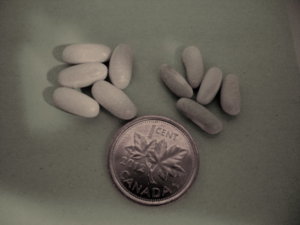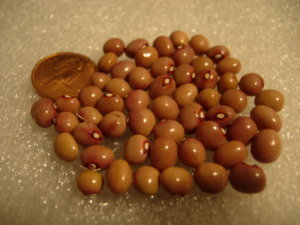Pulsegleaner
Garden Master
- Joined
- Apr 18, 2014
- Messages
- 3,334
- Reaction score
- 6,399
- Points
- 306
- Location
- Lower Hudson Valley, New York
Hi all
While doing my seed hunt today I came across a common bean in my sorting that is probably the smallest I have ever seen. If it wasn't for the hilum, I'd swear it was a black mung bean (I was going through mungs, and there are such things as black ones*). Normally I'd have dismissed it as an aborted immature seed, but a common bean aborted that small would be a shriveled mess, and this appears to be full formed. So it looks like I have something else odd to play around with. Compared to this, flageolet beans (including falcone) which I usually think of as the bottom of beans size wise is gigantic.
This has gotten me thinking what is the smallest seeded version of each bean anyone else has seen. Here is my list
Cowpea- I have some black cowpeas that are about the size of a lesser mung bean**
Soybean-I have a soybean seed I retrieved from some Indian Coriander that is the size of a small lentil (for the record, WILD soybean seeds are a bit bigger than that)
Pea- Back when I was in college I would often bump into peas in my searches so small I would get them confused with the vetches (I really wish I still had some of those) while the plants were super duper tiny, as were the pods (about the size of the last joint of my pinkie) they grew super fast (seed to seed in 30-45 days) which is good for my iffy weather.
Fava-Again back in college I once found two blackish brown favas (based on shape) about the size of bb-pellets. I DID plant the sound one (the other was damaged to non-viability) but a bird bit through it, so no clue as to it's final data (for all I know they could just have been some really odd shaped non-fava vetches.)
Mung-some of the mottled ones are even smaller than the standard lesser by about half.\
Azuki-again some as small as the smallest mungs
Urd-Not a lot of specimens on this.
Mothe- a normal mothe bean is about the size of a small mung, but I have ones that are almost down to large sesame seed size.
Lima and Runner -again, I have little experience with these, but I have certainly seen limas no bigger than small common beans and would imagine similarly diminutive runners exist as well.
*Well, most are actually really dark brown, but I have a lesser mung that is truly black.
**Commercial mung beans divide into two general groups, the greater (popular in China, Japan, and India) which is larger, rounder, and slightly browner and the lesser (popular in Thailand and Southeast Asia) which is smaller more cylindrical, and a much brighter shade of green.
While doing my seed hunt today I came across a common bean in my sorting that is probably the smallest I have ever seen. If it wasn't for the hilum, I'd swear it was a black mung bean (I was going through mungs, and there are such things as black ones*). Normally I'd have dismissed it as an aborted immature seed, but a common bean aborted that small would be a shriveled mess, and this appears to be full formed. So it looks like I have something else odd to play around with. Compared to this, flageolet beans (including falcone) which I usually think of as the bottom of beans size wise is gigantic.
This has gotten me thinking what is the smallest seeded version of each bean anyone else has seen. Here is my list
Cowpea- I have some black cowpeas that are about the size of a lesser mung bean**
Soybean-I have a soybean seed I retrieved from some Indian Coriander that is the size of a small lentil (for the record, WILD soybean seeds are a bit bigger than that)
Pea- Back when I was in college I would often bump into peas in my searches so small I would get them confused with the vetches (I really wish I still had some of those) while the plants were super duper tiny, as were the pods (about the size of the last joint of my pinkie) they grew super fast (seed to seed in 30-45 days) which is good for my iffy weather.
Fava-Again back in college I once found two blackish brown favas (based on shape) about the size of bb-pellets. I DID plant the sound one (the other was damaged to non-viability) but a bird bit through it, so no clue as to it's final data (for all I know they could just have been some really odd shaped non-fava vetches.)
Mung-some of the mottled ones are even smaller than the standard lesser by about half.\
Azuki-again some as small as the smallest mungs
Urd-Not a lot of specimens on this.
Mothe- a normal mothe bean is about the size of a small mung, but I have ones that are almost down to large sesame seed size.
Lima and Runner -again, I have little experience with these, but I have certainly seen limas no bigger than small common beans and would imagine similarly diminutive runners exist as well.
*Well, most are actually really dark brown, but I have a lesser mung that is truly black.
**Commercial mung beans divide into two general groups, the greater (popular in China, Japan, and India) which is larger, rounder, and slightly browner and the lesser (popular in Thailand and Southeast Asia) which is smaller more cylindrical, and a much brighter shade of green.


